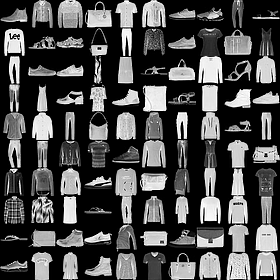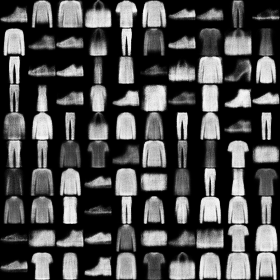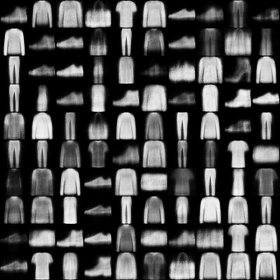
import os
import tensorflow as tf
import numpy as np
from tensorflow import keras
from tensorflow.keras import Sequential, layers
from PIL import Image
tf.random.set_seed(22)
np.random.seed(22)
os.environ["TF_CPP_MIN_LOG_LEVEL"] = '2'
def save_images(imgs, name):
# 创建一个280*280大小的图片, 默认为黑色
new_im = Image.new('L', (280, 280))
index = 0
# 以step=28*28遍历new_im的像素点
# 即往原图片上添加28*28的图片
for i in range(0, 280, 28):
for j in range(0, 280, 28):
# [b, 28, 28] => im: [28, 28]
im = imgs[index]
# 实现array到image的转换
im = Image.fromarray(im, mode='L')
# 将一张图粘贴到另一张图像上
# 第二个参数为图片的左上角位置
new_im.paste(im, (i, j))
index += 1
new_im.save(name)
h_dim = 20
batchsz = 128
lr = 1e-3
(x_train, y_train), (x_test, y_test) = keras.datasets.fashion_mnist.load_data()
x_train = x_train.astype(np.float32) / 255.
x_test = x_test.astype(np.float32) / 255.
train_db = tf.data.Dataset.from_tensor_slices(x_train)
train_db = train_db.shuffle(batchsz * 5).batch(batchsz)
test_db = tf.data.Dataset.from_tensor_slices(x_test)
test_db = test_db.batch(batchsz)
print(x_train.shape, y_train.shape)
print(x_test.shape, y_test.shape)
class AE(keras.Model):
def __init__(self):
super(AE, self).__init__()
# Encoders
self.encoder = Sequential([
layers.Dense(256, activation=tf.nn.relu),
layers.Dense(128, activation=tf.nn.relu),
layers.Dense(h_dim)
])
# Decoders
self.decoder = Sequential([
layers.Dense(128, activation=tf.nn.relu),
layers.Dense(256, activation=tf.nn.relu),
layers.Dense(784)
])
def call(self, inputs, training=None):
# [b, 784] => [b, 20]
h = self.encoder(inputs)
# [b, 20] => [b, 784]
x_hat = self.decoder(h)
return x_hat
model = AE()
model.build(input_shape=(None, 784))
model.summary()
optimizer = tf.optimizers.Adam(lr=lr)
test_iter = iter(test_db)
for epoch in range(100):
for step, x in enumerate(train_db):
# [b, 28, 28] => [b, 784]
x = tf.reshape(x, [-1, 784])
with tf.GradientTape() as tape:
x_rec_logits = model(x)
# sigmoid
rec_loss = tf.losses.binary_crossentropy(x, x_rec_logits, from_logits=True)
rec_loss = tf.reduce_mean(rec_loss)
grads = tape.gradient(rec_loss, model.trainable_variables)
optimizer.apply_gradients(zip(grads, model.trainable_variables))
if step % 100 == 0:
print(epoch, step, float(rec_loss))
# evaluation
x = next(test_iter)
logits = model(tf.reshape(x, [-1, 784]))
# 转换到0~1之间
x_hat = tf.sigmoid(logits)
# [b, 784] => [b, 28, 28]
x_hat = tf.reshape(x_hat, [-1, 28, 28])
# [b, 28, 28] => [2b, 28, 28]
# x_concat = tf.concat([x, x_hat], axis=0)
# x_concat = x_concat.numpy() * 255.
# x_concat = x_concat.astype(np.uint8)
x = x.numpy() * 255.
# 转换类型, image
x = x.astype(np.uint8)
# print(x.dtype, x.max(), x.min())
# 转换到0~255之间的像素值
x_hat = x_hat.numpy() * 255.
x_hat = x_hat.astype(np.uint8)
save_images(x, "images/%d_epochs_x.png" % epoch)
save_images(x_hat, "images/%d_epochs_rec.png" % epoch)
0_epochs_x.png 原图

0_epochs_rec.png 重构后的图


随着train的进行Mean和std将趋向于std normalization分布
可以直接通过normal分布random sample一些数据,维度同Mean/std层输出,然后直接送到decoder,将得到一些额外输出。


import os
import tensorflow as tf
import numpy as np
from tensorflow import keras
from tensorflow.keras import Sequential, layers
from PIL import Image
tf.random.set_seed(22)
np.random.seed(22)
os.environ["TF_CPP_MIN_LOG_LEVEL"] = '2'
def save_images(imgs, name):
# 创建一个280*280大小的图片, 默认为黑色
new_im = Image.new('L', (280, 280))
index = 0
# 以step=28*28遍历new_im的像素点
# 即往原图片上添加28*28的图片
for i in range(0, 280, 28):
for j in range(0, 280, 28):
# [b, 28, 28] => im: [28, 28]
im = imgs[index]
# 实现array到image的转换
im = Image.fromarray(im, mode='L')
# 将一张图粘贴到另一张图像上
# 第二个参数为图片的左上角位置
new_im.paste(im, (i, j))
index += 1
new_im.save(name)
h_dim = 20
batchsz = 128
lr = 1e-3
(x_train, y_train), (x_test, y_test) = keras.datasets.fashion_mnist.load_data()
x_train = x_train.astype(np.float32) / 255.
x_test = x_test.astype(np.float32) / 255.
train_db = tf.data.Dataset.from_tensor_slices(x_train)
train_db = train_db.shuffle(batchsz * 5).batch(batchsz)
test_db = tf.data.Dataset.from_tensor_slices(x_test)
test_db = test_db.batch(batchsz)
print(x_train.shape, y_train.shape)
print(x_test.shape, y_test.shape)
z_dim = 10
class VAE(keras.Model):
def __init__(self):
super(VAE, self).__init__()
# Encoder
self.fc1 = layers.Dense(128)
self.fc2 = layers.Dense(z_dim) # get mean prediction [b, z_dim]
self.fc3 = layers.Dense(z_dim) # get variance
# Decoder
self.fc4 = layers.Dense(128)
self.fc5 = layers.Dense(784)
def encoder(self, x):
h = tf.nn.relu(self.fc1(x))
# get mean
mu = self.fc2(h)
# get variance
log_var = self.fc3(h)
return mu, log_var
def decoder(self, z):
out = tf.nn.relu(self.fc4(z))
out = self.fc5(out)
return out
def reparameter(self, mu, log_var):
eps = tf.random.normal(log_var.shape)
# exp(1/2 * log(x))
std = tf.exp(log_var * 0.5)
z = mu + std * eps
return z
def call(self, inputs, training=None):
# [b, 784] => [b, z_dim], [b, z_dim]
mu, log_var = self.encoder(inputs)
# reparameterization trick
z = self.reparameter(mu, log_var)
x_hat = self.decoder(z)
return x_hat, mu, log_var
model = VAE()
model.build(input_shape=(4, 784))
optimizer = tf.optimizers.Adam(lr)
for epoch in range(1000):
for step, x in enumerate(train_db):
x = tf.reshape(x, [-1, 784])
with tf.GradientTape() as tape:
x_rec_logits, mu, log_var = model(x)
rec_loss = tf.nn.sigmoid_cross_entropy_with_logits(labels=x, logits=x_rec_logits)
rec_loss = tf.reduce_sum(rec_loss) / x.shape[0]
# compute kl divergence (mu, var) ~ N (0, 1)
# https://stats.stackexchange.com/questions/7440/kl-divergence-between-two-univariate-gaussians
kl_div = -0.5 * (log_var + 1 - mu ** 2 - tf.exp(log_var))
kl_div = tf.reduce_sum(kl_div) / x.shape[0]
loss = rec_loss + 1. * kl_div
grads = tape.gradient(loss, model.trainable_variables)
optimizer.apply_gradients(zip(grads, model.trainable_variables))
if step % 100 == 0:
print(epoch, step, 'kl div:', float(kl_div), 'rec loss:', float(rec_loss))
# evaluation [b, 10]
z = tf.random.normal((batchsz, z_dim))
logits = model.decoder(z)
x_hat = tf.sigmoid(logits)
x_hat = tf.reshape(x_hat, [-1, 28, 28]).numpy() * 255.
x_hat = x_hat.astype(np.uint8)
save_images(x_hat, "images2/sample_epoch%d.png" % epoch)
x = next(iter(test_db))
x = tf.reshape(x, [-1, 784])
x_hat_logits, _, _ = model(x)
x_hat = tf.sigmoid(x_hat_logits)
x_hat = tf.reshape(x_hat, [-1, 28, 28]).numpy() * 255.
x_hat = x_hat.astype(np.uint8)
save_images(x_hat, "images2/rec_epoch%d.png" % epoch)
rec_epoch0.png 重构后的

sample_epoch0.png smaple出来的
